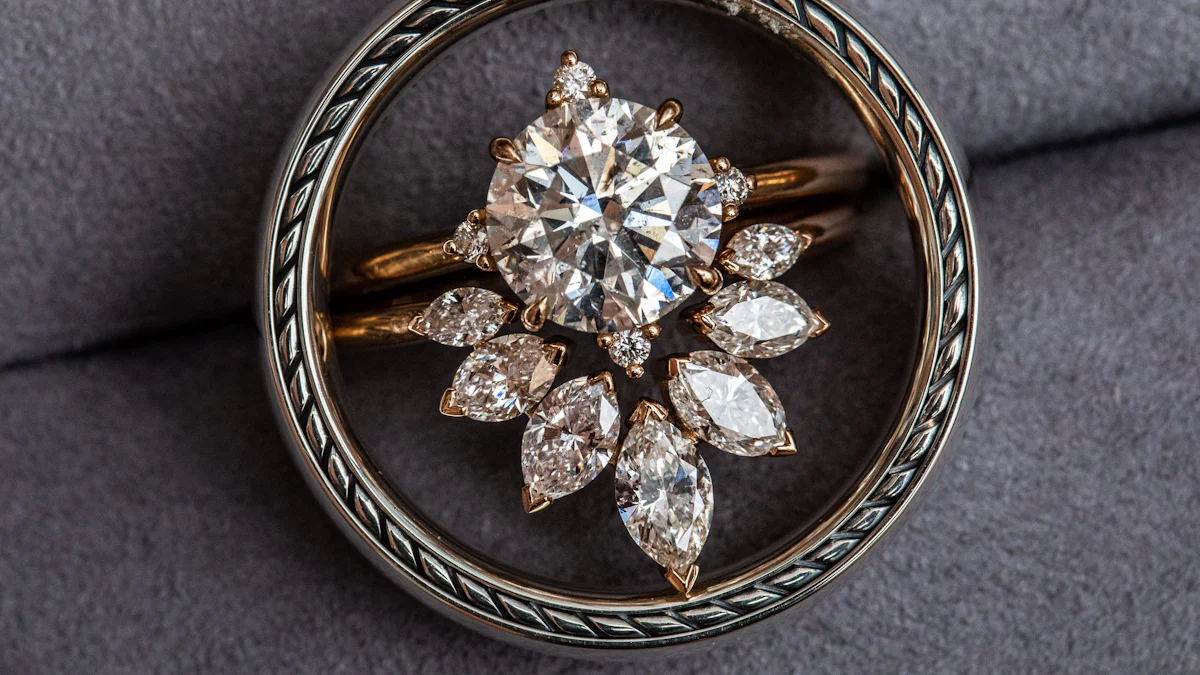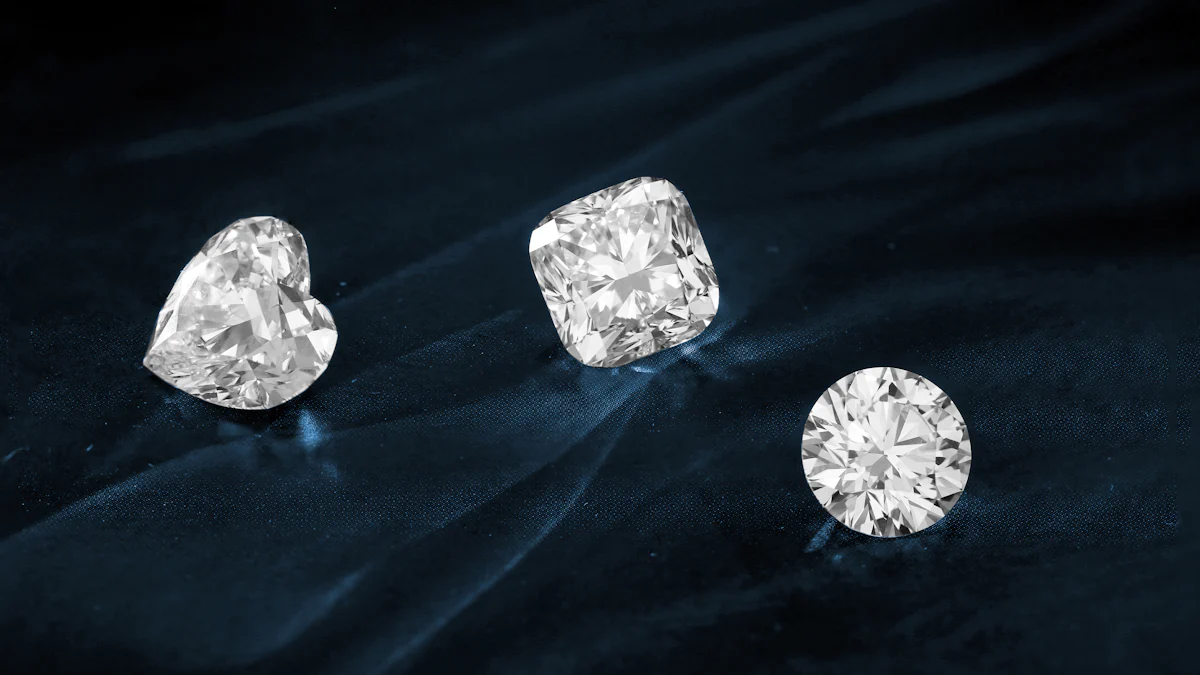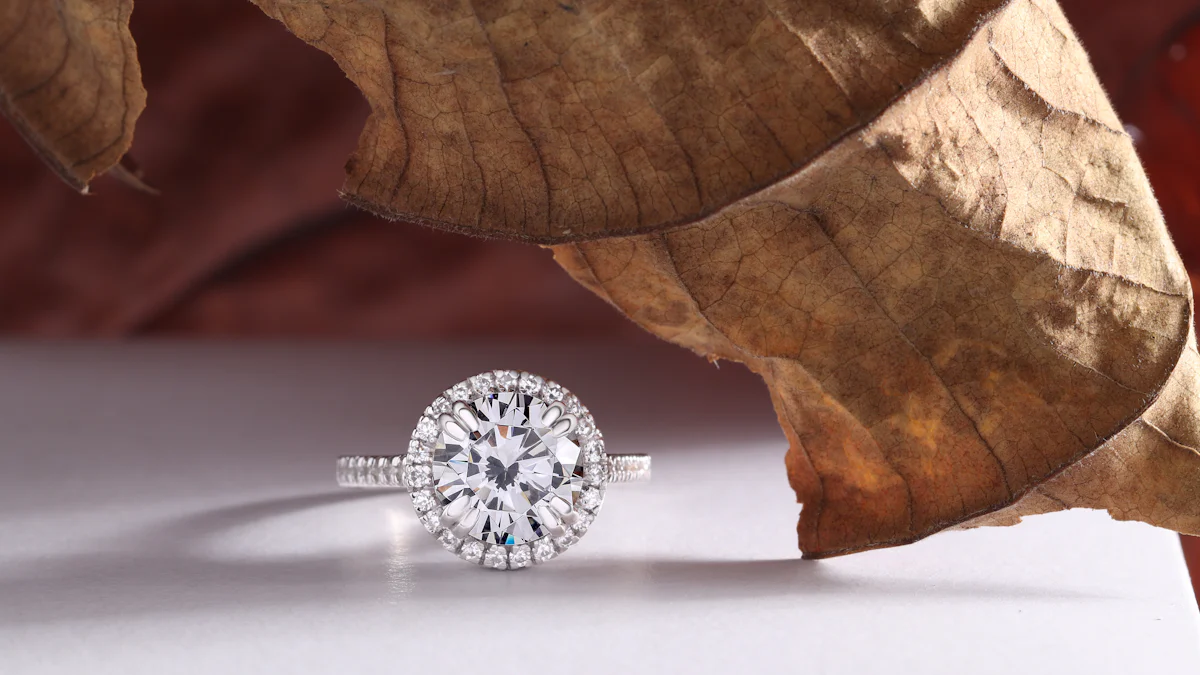Understanding T.W. Diamond Meaning and Weight Terms

When you’re shopping for diamonds, you’ll often see terms like T.W., CTW, and CTTW. These aren’t just random abbreviations—they’re essential for understanding the weight of the diamonds in your jewelry. Knowing what these terms mean helps you make smarter choices and ensures you get the best value for your money.
For example, the total weight (TW) of diamonds in a piece directly impacts how it’s perceived. Take a look at this breakdown:
| Total Weight Range | Perceived Value | |---------------------|-----------------| | < 0.50 CT TW | Lower value | | 0.50-1.00 CT TW | Medium value | | > 1.00 CT TW | Higher value |
As you can see, the higher the TW, the more valuable the jewelry appears. Understanding the T.W. diamond meaning can help you spot the difference between a single large diamond and multiple smaller ones with the same total weight. This knowledge ensures you’re not just paying for size but also for quality and design.
T.W. Diamond Meaning and Its Importance
What Does T.W. Stand For?
T.W. stands for "total weight." When you see this term on a jewelry tag, it refers to the combined weight of all the diamonds in that piece. For example, if a bracelet has several small diamonds, their weights are added together to give you the total weight or TW. This term is especially common in multi-stone jewelry, like diamond engagement rings or tennis bracelets.
It’s important to note that T.W. doesn’t tell you the weight of each individual diamond. Instead, it gives you the overall weight of all the stones combined. If you’re looking at a piece with multiple diamonds, the TW can help you understand its overall size and value.
Why Understanding T.W. Matters in Jewelry Shopping
When you’re shopping for diamond jewelry, understanding the T.W. diamond meaning can save you from confusion. It’s easy to assume that a higher TW means a larger single diamond, but that’s not always the case. A piece with a higher TW might have many smaller diamonds instead of one big stone.
This distinction matters because the value of diamonds isn’t just about their total carat weight. The 4 C’s—cut, color, clarity, and carat—play a huge role in determining a diamond’s worth. A single diamond with excellent clarity and cut might be more valuable than multiple diamonds with the same TW but lower quality.
Knowing the T.W. diamond meaning also helps you compare pieces more effectively. For example, if you’re choosing between two diamond engagement rings, one might have a higher TW but smaller individual stones. The other might feature a single, larger diamond with a lower TW. By understanding TW, you can decide which option fits your style and budget better.
Tip: Always ask your jeweler about the individual carat weight of each diamond in a piece. This ensures you know exactly what you’re paying for.
CTTW and Total Carat Weight Explained

What Is CTTW in Diamond Jewelry?
CTTW stands for "carat total weight." It measures the combined carat weight of all diamonds in a piece of jewelry. This includes the center stone and any smaller diamonds that enhance the design. For example, if a necklace features a 0.75-carat center diamond and two smaller diamonds weighing 0.25 carats each, the CTTW would be 1.25 carats (0.75 + 0.25 + 0.25).
This term is especially helpful when you're shopping for multi-stone jewelry. It gives you a clear idea of the total carat weight of all the diamonds in the piece. However, keep in mind that CTTW doesn’t tell you the size or quality of each individual diamond.
Tip: Always ask your jeweler about the breakdown of the CTTW. This ensures you know how much of the total weight comes from the center stone versus the smaller diamonds.
How CTTW Relates to Total Carat Weight
CTTW and total carat weight are essentially the same thing. Both terms refer to the combined carat weight of all diamonds in a piece of jewelry. Whether you see "CTTW" or "total carat weight" on a jewelry tag, they mean the same thing.
Understanding this relationship helps you evaluate the overall value of a piece. For instance, a ring with a high total carat weight might look impressive, but the individual diamonds could be smaller or of lower quality. Knowing how CTTW works allows you to make more informed decisions when comparing jewelry options.
Are CTW and CTTW the Same?
While CTW and CTTW are often used interchangeably, they both refer to the total weight of all diamonds in a piece of jewelry. The key difference lies in the terminology. CTW stands for "carat total weight," while CTTW stands for "carat total weight" as well. Essentially, they mean the same thing, but jewelers may use one term over the other.
Understanding these terms ensures you’re not confused by different labels. Whether it’s CTW or CTTW, both describe the total weight of all diamonds in the jewelry.
Diamond Carat Weight vs. Total Carat Weight
Defining Diamond Carat Weight
When you hear the term "diamond carat weight," it refers to the weight of a single diamond. This measurement is incredibly precise. In fact, one carat equals 200 milligrams, and jewelers divide each carat into 100 points for accuracy. For example, a diamond weighing 0.75 carats is often called a "75-pointer."
Diamonds are typically weighed using an electronic micro-balance scale, which measures to the fifth decimal place (1.12345) for maximum precision.
Here’s how carat weight is measured:
- Carat weight is calculated to the thousandth of a carat and rounded to the nearest hundredth.
- Jewelers use specialized tools to ensure precise measurements.
This level of accuracy ensures you know exactly what you’re getting when you purchase a diamond.
Total Carat Weight in Multi-Stone Jewelry
Total carat weight, or carat total weight, describes the combined weight of all diamonds in a piece of jewelry. For instance, if a ring has a center diamond weighing 0.50 carats and two smaller diamonds weighing 0.25 carats each, the total carat weight would be 1.00 carat.
| Aspect | Carat Weight | Total Carat Weight | |-----------------------|----------------------------------|----------------------------------------| | Definition | Weight of a single diamond | Weight of all diamonds in a piece | | Pricing Impact | Directly affects price | Influences price but less than center stone | | Consumer Perception | Seen as more valuable | Considered for overall weight |
Understanding this distinction is crucial. While total carat weight gives you an idea of the overall size of the diamonds in a piece, the center diamond’s weight often has the biggest impact on price and appearance.
Common Misconceptions About Carat Weight and Size
It’s easy to assume that carat weight directly translates to size, but that’s not true. Carat is a measure of weight, not size. A diamond’s cut and density can significantly affect how large it looks. For example, a one-carat round diamond typically measures about 6.4mm in diameter, while a one-carat sapphire might measure closer to 6.0mm.
Here are some common misconceptions to watch out for:
- Carat weight alone doesn’t determine a diamond’s size.
- A poorly cut diamond may appear smaller than a well-cut one of the same weight.
- The perceived size of a diamond depends on its cut grade and proportions.
Tip: Always consider carat weight and cut together to ensure the diamond looks as stunning as possible.
By understanding these nuances, you can avoid common pitfalls and choose a diamond that truly meets your expectations.
How Diamond Weight Terms Affect Pricing and Appearance

Pricing Based on Total Carat Weight
When it comes to pricing, total carat weight plays a big role, but it’s not the only factor. Larger diamonds are rarer, so their price per carat increases significantly as the carat weight goes up. For example, a 1-carat diamond costs much more per carat than a 0.50-carat diamond of the same quality. This is why a ring with a 1.00-carat center stone and smaller side stones often costs more than a piece with the same total carat weight but smaller individual diamonds.
Other factors like cut, clarity, and color also influence the price. A diamond with excellent clarity and a brilliant cut will cost more than one with lower grades, even if their total carat weight is the same. So, when you’re shopping, don’t just focus on the total weight. Look at the quality of each diamond to ensure you’re getting the best value.
Tip: Always ask about the price per carat for the diamonds in a piece. This will help you understand how the total carat weight and cost are connected.
The Impact of Total Weight on Jewelry Design
Total weight doesn’t just affect the price—it also shapes the design of the jewelry. Smaller diamonds can enhance the appearance of a center stone, making it look larger and more radiant. For example, a halo setting surrounds the main diamond with smaller stones, boosting its visual impact without adding too much to the total carat weight.
Multi-stone designs also allow for creative freedom. You can choose different shapes, sizes, and settings to create a unique look. Plus, smaller diamonds can cover more surface area, giving you a bold and elegant design without the cost of a single large diamond.
Note: Total carat weight is especially important in multi-stone jewelry. It determines the overall balance and brilliance of the piece.
Examples of Pricing Differences in Single vs. Multi-Stone Jewelry
The way diamonds are arranged in a piece can create noticeable differences in price. A single large diamond often costs more than multiple smaller diamonds with the same total carat weight. For instance, a solitaire ring with a 1-carat diamond will usually be more expensive than a ring with several smaller diamonds adding up to 1 carat total weight.
This happens because larger diamonds are rarer and have a higher price per carat. However, multi-stone designs can still look stunning and offer better value for your budget. For example, a three-stone ring with a 0.50-carat center diamond and two 0.25-carat side stones can give you a total weight of 1.00 carat while costing less than a solitaire ring with a single 1-carat diamond.
Tip: If you’re on a budget, consider multi-stone designs. They maximize the diamond total weight while keeping the price more affordable.
Tips for Interpreting Diamond Weight Terms
Ask Jewelers for Clarification
When you're shopping for diamond jewelry, don't hesitate to ask questions. Jewelers are there to help you understand what you're buying. Start by asking them to explain how carat weight affects the diamond's appearance. For example, a diamond with a higher carat weight might not always look bigger if the cut isn't ideal. You can also inquire about how the cut influences the diamond size. A well-cut diamond can appear larger and more brilliant than one with a poor cut, even if their weights are the same.
Another great tip is to request a side-by-side comparison of diamonds within your budget. Seeing different carat weights and sizes in person helps you make a more informed decision. This way, you can balance the diamond's weight with its quality, ensuring you get the best value for your money.
Tip: Always ask about the diamond's cut, clarity, and color. These factors, along with carat weight, determine the overall beauty and value of the piece.
Use Online Tools to Compare Diamond Sizes
Online tools can be a lifesaver when you're trying to understand diamond sizes and weights. A diamond size chart is a great place to start. It visually compares diamonds in popular shapes, ranging from 0.25 to 5 carats, and includes their actual diameters. Another helpful tool is the diamond carat size chart, which provides detailed comparisons of carat weights across various shapes.
These tools make it easier to visualize how a diamond will look once it's set in jewelry. They also help you understand how carat weight translates to size for different cuts. For example, a 1-carat round diamond will look different from a 1-carat oval diamond. Using these resources ensures you're confident in your choice before making a purchase.
Note: While online tools are helpful, always verify the diamond's weight and size with your jeweler to ensure accuracy.
Consider the Jewelry Setting and Design
The setting and design of your jewelry can greatly influence how the diamond's weight is perceived. A white metal band, like platinum or white gold, reflects light and can make the diamond appear larger. On the other hand, a rose or yellow gold band creates contrast, which can also enhance the diamond's size visually.
The prongs holding the diamond also play a role. Slender prongs show more of the diamond, making it look bigger. However, the prongs must be strong enough to secure the stone. A well-designed setting balances beauty and security, ensuring your diamond looks stunning while staying safe.
Tip: When choosing a setting, consider how it complements the diamond's cut and carat weight. A good design enhances the diamond's brilliance and overall appearance.
Focus on Diamond Quality Alongside Weight
When you're shopping for diamonds, it’s easy to get caught up in the numbers. You might think a higher carat weight automatically means a better diamond. But here’s the truth: weight isn’t everything. Diamond quality plays a huge role in how stunning a piece looks and how much it’s worth.
Think about this. A diamond with a high carat weight but poor clarity or a dull cut won’t sparkle the way you’d expect. On the other hand, a smaller diamond with excellent cut, color, and clarity can outshine a larger one. The 4 C’s—cut, color, clarity, and carat—work together to determine a diamond’s overall beauty. Ignoring any of these factors could leave you with a diamond that doesn’t meet your expectations.
Cut is especially important. It affects how light reflects through the diamond, creating that brilliant sparkle everyone loves. Even if a diamond has a high carat weight, a poor cut can make it look lifeless. Clarity matters too. If a diamond has visible flaws, they can distract from its beauty, no matter how big it is.
You should also consider how the diamond will look in its setting. A well-cut diamond with a lower carat weight can appear larger and more radiant when paired with the right design. For example, a halo setting can make a smaller diamond look bigger by surrounding it with tiny diamonds.
So, don’t just focus on carat weight. Pay attention to diamond quality. This ensures you’re investing in a piece that’s not only valuable but also breathtaking.
Tip: Always ask your jeweler for a detailed explanation of the diamond’s cut, clarity, and color. These factors, combined with weight, will help you find the perfect piece.
Understanding terms like T.W., CTW, and CTTW is key when buying diamond jewelry. These terms help you evaluate the combined weight of diamonds in a piece and compare options effectively. Always verify individual diamond weights since larger diamonds often hold more value. Don’t let misleading labels confuse you. Focus on balancing carat weight with quality to ensure your jewelry shines brilliantly. Consult a jeweler or use online tools to make informed choices. With this knowledge, you’ll confidently select a piece that matches your style and budget.
FAQ
What’s the difference between carat weight and total carat weight?
Carat weight refers to the weight of a single diamond. Total carat weight combines the weight of all diamonds in a piece. For example, a ring with one diamond weighing 1 carat differs from a ring with multiple diamonds adding up to 1 carat.
Does a higher carat weight always mean a bigger diamond?
Not always. Carat measures weight, not size. A diamond’s cut and shape affect how large it looks. A well-cut diamond can appear bigger than a poorly cut one of the same weight. Always consider both weight and cut when choosing diamonds.
Why are larger diamonds more expensive per carat?
Larger diamonds are rarer, which increases their value. A 2-carat diamond costs more per carat than two 1-carat diamonds of the same quality. The rarity and demand for bigger diamonds drive up their price significantly.
How can I tell if a diamond’s weight is worth the price?
Focus on the 4 C’s: cut, color, clarity, and carat. A diamond with excellent cut and clarity often looks better than a heavier one with flaws. Ask your jeweler for details about the diamond’s quality to ensure it’s worth the cost.
Can smaller diamonds with the same total weight look better than one large diamond?
Yes! Smaller diamonds in creative settings, like halos or clusters, can enhance the overall sparkle and design. They often cost less than a single large diamond of the same weight while offering a bold and elegant appearance.
See Also
Comparing Tungsten Diamond Rings With Traditional Options
Exploring Different Diamond Cuts For Engagement Rings
The Fascination Behind Diamond Dust Rings Explained

